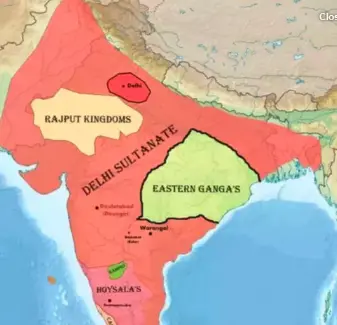Orissa’s rich history begins in the mid-7th century under the rule of Sainyabhita Madhavavarman, known for his Ashwamedha sacrifice. Successive dynasties, like the Karas and Bhanjas, shaped its governance, while the Eastern Ganga Kingdom emerged around AD 500, ruling for nearly a millennium. Despite early obscurity, leaders like Anantavarman Chodaganga brought about resurgence, expanding territory and commissioning architectural marvels like the Jagannath and Sun Temples.
The Eastern Ganga Kingdom
Rule of Sainyabhita Madhavavarman: In the mid-7th century, Orissa was under the rule of Sainyabhita Madhavavarman (Srinivasa) of the Shailodbhava dynasty, noted for performing the Ashwamedha sacrifice.
-
- Successive Dynasties in Orissa: This dynasty held sway until the mid-8th century. Afterwards, Orissa was governed by several dynasties, notably the Karas and Bhanjas, with the Kara dynasty witnessing at least five female rulers.
- Introduction to the Eastern Ganga Kingdom: Emerged around AD 500 and ruled for almost a millennium.
- Territory: spanned Orissa, West Bengal, Chattisgarh, Jharkhand, and Andhra Pradesh.
- Origins and Capital: Potentially related to Western Gangas of Mysore, but debate exists.
- Early Capital: at Kalinganagara (modern Andhra Pradesh).
- Secondary Capital: at Dantapura (Palur)

- Early rulers are known mainly from inscriptions.
- Samantavarman ruled around AD 535-554.
- Devendravarman mentioned around AD 537/538, possible misreading of Indravarman.
- Hastivarman ruled around AD 554-583.
- Eastern Gangas: related to the Gangas of Mysore, established their domain in Kalinga, with Kalinganagara as their capital.
- Intervening Period: Period of obscurity until the emergence of Vajrahasta Anantavarman in early 11th century.
-
-
- Eastern Chalukyas and Chola kings conquered Orissa in the 10th century.
- Resurgence under Anantavarman: Reign marked by re-establishment of power.
-
- Expansion into Pala territories.
- Leadership of Anantavarman Chodaganga: A significant ruler, Anantavarman Chodaganga, unified Utkal and Kalinga, and succeeded his father around 1078 AD, enhancing Orissa’s territorial extent.
- Expansion and Architectural Marvels:
- Construction of the Jagannath Temple: Despite facing a Chola attack, he annexed their lands, extending his kingdom from “Ganga to Godavari,” and laying the foundation for modern Orissa; constructed the Jagannath temple.
- Resistance Against Chola Attacks: The kingdom maintained control up to the Ganges and resisted invasions from Bengal, including one from Bhaktiyar Khalji.
- Commissioning of the Sun Temple: Narasimha I (1238-1264) commissioned the construction of Sun Temple at Konark.
- In the mid-15th century, a new royal family, the Suryavamsas, came to power in Kalinga.
- Construction of the Lingaraj Temple: Lingaraj temple, Bhubaneswar (related to Shiva) was built by Somvanshi King Yayati I.
- Later Ganga Kings and Decline: Continuation of lineage with successive rulers.
- Various Conflicts: with neighboring kingdoms and invasions.
- Conquests and losses of territories.
- Continuous attacks weaken the kingdom’s power.
- End of Ganga Dynasty and Rise of Suryavamsa Gajapati Kingdom: Bhanudeva IV’s reign marked by instability.
- Kapilendra: He was a minister, usurped the throne, established the Suryavamsa dynasty.
- Gajapatis: conquer Rajamahendri from Vijaynagar empire.
- Dynasty lasted till the 15th century under various rulers.
- Bhoi Dynasty and British Rule: Govinda Vidyadhara establishes Bhoi dynasty, overthrows the last Gajapati.
- Rule over Orissa: Orissa comes under Bengal, then Mogul, then Maratha rule.
- Mukundadeva II: imprisoned by East India Company in 1818, marking British rule.
Conclusion
Orissa’s history is a tapestry of dynastic shifts, conflicts, and architectural achievements. From the reign of Sainyabhita Madhavavarman to the rise of the Suryavamsa Gajapati Kingdom and the eventual British rule, Orissa’s story reflects the resilience and dynamism of its people and rulers. The legacy of its ancient kingdoms, monumental temples, and cultural heritage continues to inspire and enrich the fabric of modern-day Odisha.
![]() May 16, 2024
May 16, 2024
![]() 7608
7608
![]() 0
0
